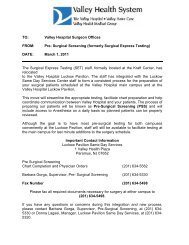Obstetrical Delivery Consent Form - Valley Hospital
Obstetrical Delivery Consent Form - Valley Hospital
Obstetrical Delivery Consent Form - Valley Hospital
Create successful ePaper yourself
Turn your PDF publications into a flip-book with our unique Google optimized e-Paper software.
THE VALLEY HOSPITALRidgewood, New JerseyPATIENT INFORMATION SHEETON ANESTHESIAThe purpose of surgical anesthesia is to relieve pain during surgery through the use of various medications ordrugs known as anesthetic agents. Along with the delivery of the anesthetic agent, life support measures areoften undertaken in order to maintain the well-being of the patient. These measures might include theadministration of blood or blood products (unless such blood or blood products have been refused); use ofmedications and equipment to support the heart, lungs or other systems of the body; antibiotics (drugs used toprevent or treat infection); and medications to counteract disease states or correct imbalances.Surgical anesthesia may be general, regional or local with intravenous conscious sedation. The type ofanesthesia selected in a given case will depend on the medical condition of the patient, the nature of theprocedure to be performed, and the preferences of the patient and of the surgeon.General anesthesia is a method of surgical anesthesia in which the patient is rendered unconscious andinsensitive to pain (will be asleep) through the use of anesthetic agents administered by inhalation (breathing ananesthetic gas through a mask) and/or by intravenous injection (using a small tube (catheter) to place theanesthetic agent into a vein and, thus, into the patient's bloodstream). The anesthetic agent, the route ofadministration, the dosage, and the depth of general anesthesia are dependent on the nature of the surgery to beperformed, the medical condition of the patient, and other considerations. Endotracheal intubation, in which abreathing tube is placed into the windpipe, is often necessary. Occasionally, patients complain of a sore throat,nausea and/or vomiting after undergoing general anesthesia. Strokes, brain damage and heart attack are rarecomplications of general anesthesia.Regional anesthesia is a method of surgical anesthesia in which anesthetic agents are used to numb a group ofsensory nerve fibers in order to make an area of the body insensitive to pain. Sometimes a tourniquet is used onan arm or leg and an anesthetic agent is injected into a vein of that arm or leg. During this type of anesthesia asedative to relax and calm the patient during the surgery is used. Occasionally, for technical reasons, it is notpossible to produce this type of anesthesia or it is not completely satisfactory. When this occurs another type ofanesthesia, usually a general anesthetic, is added. Two of the commonly used types of regional anesthesia areepidural and spinal anesthesia.Local anesthesia with intravenous sedation is where a local anesthetic agent is injected into the site to beoperated on by the surgeon to block sensory nerves. This makes that area of the body insensitive to pain ornumb. During this type of anesthesia, a sedative to relax and calm the patient is often given intravenously.In epidural anesthesia an anesthetic agent is injected into the epidural space to anesthetize (numb) the legs,pelvis, abdomen, or other area of the body. With this type of anesthesia a small tube (catheter) is inserted intothe epidural space so that additional anesthetic agent can be injected as needed. Rare complications of epiduralanesthesia include infection and paralysis.In spinal anesthesia the lower part of the body is made insensitive to pain by injecting an anesthetic agent intothe fluid which bathes the spinal cord. Infrequently, a post-spinal headache may occur. Rare complications ofspinal anesthesia include infection and paralysis.On the day of surgery, your anesthesiologist will speak with you to answer any questions you may have. If youwish to speak with an anesthesiologist prior to this, please call the Anesthesiology Department at (201) 447-8700.IC-2 MRec Page 6 of 707/96,10/98, 01/02
















